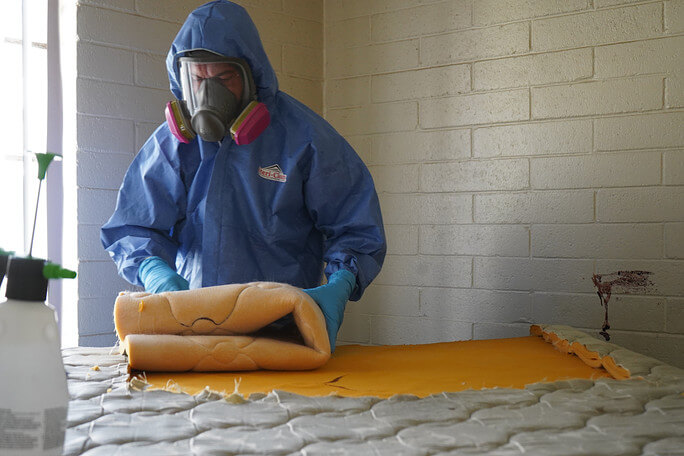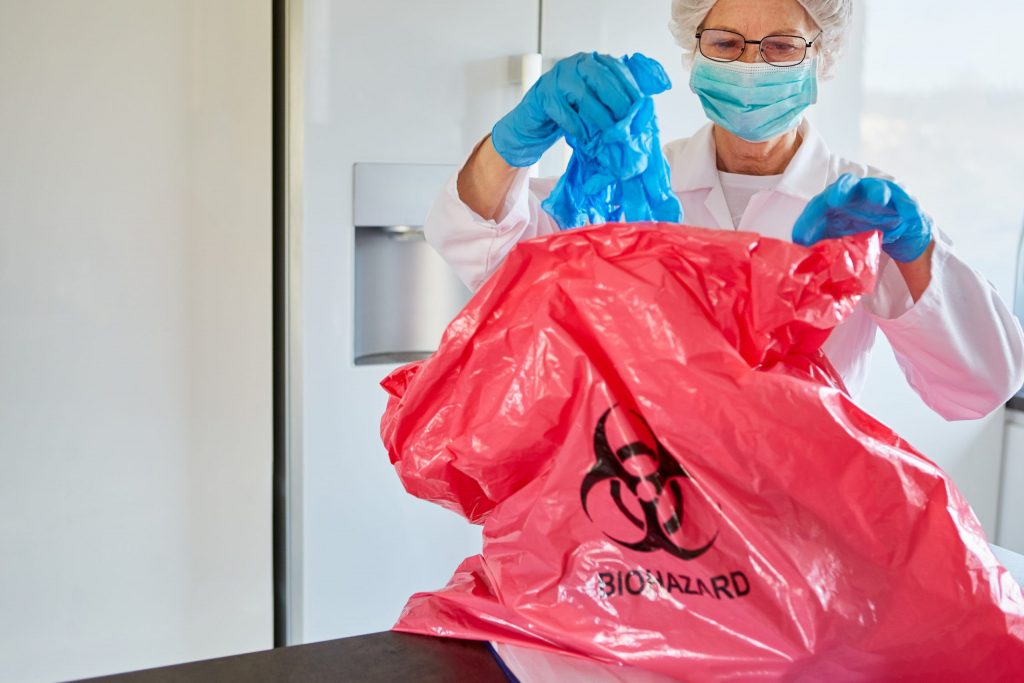Clandestine Lab Cleanup: Comprehensive Decontamination for Hazardous Sites
Clandestine Lab Cleanup: Comprehensive Decontamination for Hazardous Sites
Blog Article
Specialist Biohazard Cleansing and Purification for Blood, Bodily Fluids, and Hazardous Materials
The prospective wellness risks linked with direct exposure to biohazards highlight the crucial demand for careful handling and comprehensive clean-up. As we navigate the complex landscape of biohazard cleaning, comprehending the subtleties of policies, conformity, and the specific tools at play becomes imperative in making sure a secure and extensive decontamination process.
Health And Wellness Threats of Biohazard Direct Exposure
Exposure to biohazards presents significant health and wellness threats that can result in severe repercussions for people and areas alike. Biohazards include a vast array of organic substances, including blood, physical liquids, mold and mildew, microorganisms, infections, and other possibly transmittable products. When people enter into contact with these biohazards, whether through accidents, incorrect handling, or environmental exposure, they deal with the risk of having serious health problems or conditions.
Among the key wellness threats related to biohazard direct exposure is the transmission of transmittable conditions. Bloodborne virus such as HIV, liver disease B and C, and different germs can be present in biohazardous materials, positioning a direct risk to human health. Breathing in airborne biohazards like mold spores or entering contact with contaminated surface areas can additionally cause respiratory system problems, allergies, and various other unfavorable wellness results.
In addition, biohazard direct exposure can have long-lasting health and wellness implications, with some diseases showing up years after the preliminary get in touch with (Blood Cleanup). For that reason, it is important to prioritize correct biohazard cleansing and decontamination to mitigate these wellness dangers and make sure the security of neighborhoods and individuals

Specialized Educating for Biohazard Cleanup
When it involves managing biohazard cleanup efficiently and safely, specialized training plays a basic role in making sure correct decontamination procedures are complied with. Biohazard cleanup calls for details understanding and abilities to efficiently alleviate threats connected with bloodborne pathogens, physical liquids, and unsafe materials. Professionals educated in biohazard cleaning undertake rigorous instruction on exactly how to securely take care of, get rid of, and dispose of biohazardous materials to protect against contamination and exposure.
Specialized training for biohazard cleanup covers a series of necessary subjects, consisting of correct individual protective devices (PPE) usage, bloodborne microorganism understanding, purification strategies, and unsafe waste disposal methods. People educated in biohazard cleaning are equipped with the needed proficiency to evaluate contamination levels, identify potential risks, and execute suitable cleanup procedures in compliance with regulatory standards.
Constant training and education are paramount in the field of biohazard clean-up to stay updated on the most up to date purification modern technologies, safety and security methods, and guidelines. By purchasing specialized training, biohazard cleanup specialists can properly react to emergency cleanup scenarios and guard both public health and wellness and the atmosphere.
Significance of Proper Decontamination Techniques
Making use of appropriate decontamination techniques is crucial in biohazard cleaning to successfully get rid of hazardous products and reduce health and wellness threats. Efficient decontamination not just guarantees the elimination of visible traces of blood, physical fluids, and other biohazards but additionally targets undetectable pathogens that might position significant health and wellness threats otherwise properly removed. By adhering to rigid decontamination procedures, trained experts can considerably lower the threat of exposure to hazardous microorganisms, infections, and germs that can result in conditions or infections.
Proper purification strategies involve the usage of customized equipment and disinfectants that are especially made to neutralize biohazards successfully. Extensive cleansing and sanitation of contaminated areas are vital to prevent the spread of microorganisms and make sure a secure environment for occupants. Additionally, the proper disposal of biohazardous waste complying with decontamination procedures is important in protecting against contamination of other surfaces or individuals.

Tools and Devices for Safe Cleaning
The proper devices and devices play a crucial function in guaranteeing the effective and risk-free cleaning of biohazardous materials. When managing blood, bodily fluids, or harmful products, biohazard cleansing specialists depend on specialized gear to minimize direct exposure risks and extensively decontaminate the afflicted area. Personal protective devices (PPE) such as handwear covers, coveralls, goggles, and masks are necessary to protect biohazard cleanup license versus direct contact with possibly contagious materials. Additionally, biohazard cleansing packages having anti-bacterials, absorbent materials, and biohazard bags are used to securely dispose and contain of contaminated things. Blood Cleanup.
Advanced cleaning tools like hospital-grade disinfectants, HEPA-filtered vacuums, and fogging makers are utilized to sanitize surface areas and eliminate biohazards efficiently. Specialized devices such as sharps containers and biohazard garbage disposal bins are made use of to safely handle sharp items and biohazardous waste products. By using the best devices and tools, biohazard cleansing professionals can guarantee an extensive clean-up procedure that focuses on safety and reduces health and wellness dangers for both workers and residents of the afflicted room.
Rules and Conformity in Biohazard Cleansing
Correct adherence to regulations and compliance standards is critical in biohazard cleansing to make sure the safety and security of both employees and the atmosphere. Federal government firms such as OSHA (Occupational Safety And Security and Wellness Management) and the EPA (Epa) have established particular guidelines for biohazard cleanup procedures to minimize health and wellness dangers and environmental contamination. These guidelines cover a variety of elements including the handling, transportation, and disposal of biohazardous materials, as well as the necessary training and protective equipment required for employees entailed in the cleaning procedure.
Biohazard cleansing business need to remain current with these laws click for info to assure that their procedures satisfy the needed security requirements. Failure to abide by these policies can lead to extreme repercussions, including fines, lawsuit, and endangering the health of individuals and the setting. By complying with strict regulations and conformity procedures, biohazard cleaning firms can properly minimize threats and make sure a detailed and risk-free cleaning process for all parties entailed.
Final Thought
In final thought, biohazard cleaning and purification require customized training, appropriate strategies, and adherence to laws. Exposure to blood, physical fluids, and harmful materials presents significant health and wellness risks, making it crucial to utilize the right equipment and tools for risk-free clean-up. By complying with strict procedures and guidelines, specialists can efficiently mitigate the risks connected with biohazard direct exposure and make certain the safety of both themselves and others.
As we navigate the elaborate landscape of biohazard cleanup, comprehending the subtleties of laws, conformity, and the customized equipment at play ends up being important in making certain a comprehensive and risk-free purification procedure. (Blood Cleanup)
When it comes to taking care of biohazard cleanup efficiently and safely, specialized training plays an essential function in making certain correct purification procedures are followed.Making use of appropriate decontamination techniques is important in biohazard clean-up to efficiently remove hazardous materials and minimize wellness threats. In addition, biohazard cleansing packages having anti-bacterials, absorbing products, and biohazard bags are utilized to safely include and dispose of infected things.
Government firms such as OSHA (Occupational Safety And Security and Health And Wellness Management) crime scene cleanup pay and the EPA (Environmental Security Agency) have actually developed particular guidelines for biohazard cleanup procedures to decrease wellness dangers and environmental contamination.
Report this page